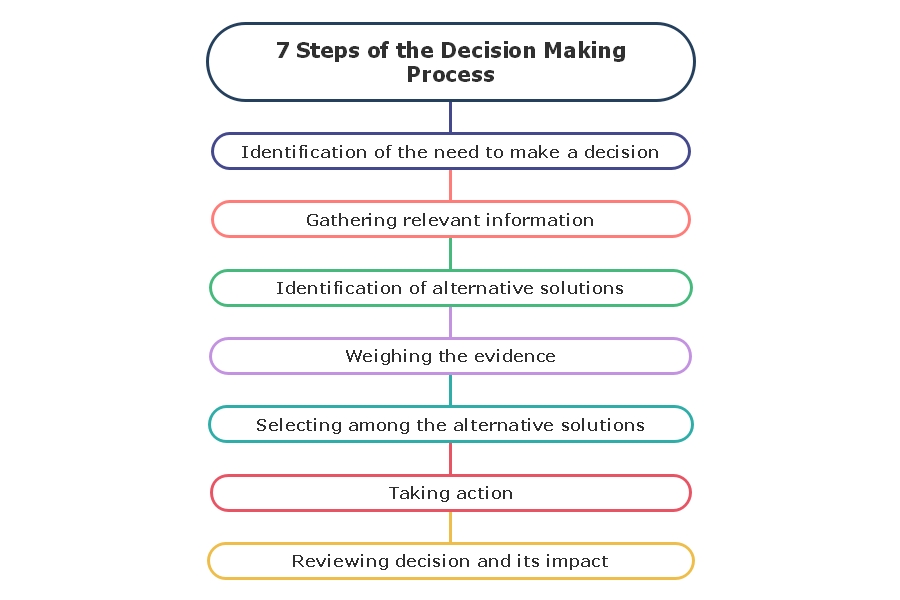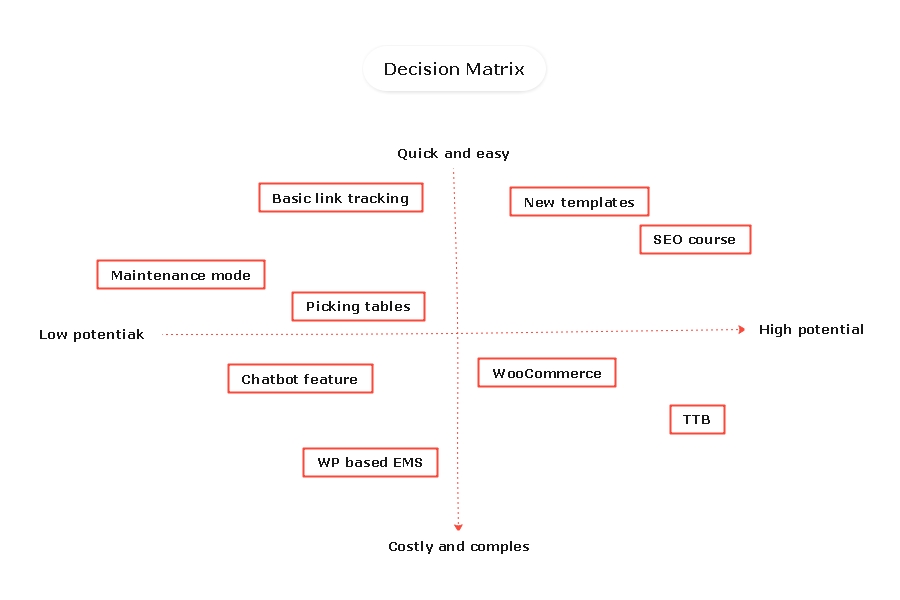What is Decision Making Process
Edraw Content Team
Do You Want to Use Decision Making Process?
EdrawMind helps move ideas forward, faster and better. Learn from this article to know everything about Decision Making Process. Just try it free now!
1. What is the Decision Making Process?
We have to make choices and decisions about different aspects of life every day. From deciding what to wear, eat, and travel to the workplace to how much to invest in a business, we have to consider different options and make informed choices. Some of these choices and decisions are easy. However, some of them are difficult. Decisions that seem problematic require deliberations, such as what career path to choose, when to start a company, what product to launch in a market, etc. These decisions are different because they have life-changing tendencies. They shape us, our lives, and our future altogether.
2. The 7 Steps of the Decision Making Process
The following seven steps are involved in making a decision:
1 Identification of the Need to Make a Decision
When you identify the need to make a decision, ask yourself these questions:
- What is the problem that needs a solution?
- What is the goal you want to achieve by solving the problem?
- What outcome will indicate the success of your decision?
These questions will help you set a goal and find ways to achieve it. When the problem is clearly defined and understood, you can pay attention to its best solution and the ways to implement that solution.
2 Gathering Relevant Information
Another important step toward making a decision is gathering relevant information. This assists in making informed and effective decisions. You need to have the historical data and the timeline of different attempts made to solve a particular problem. You can also look for input from your teammates or company employees. Moreover, doing market research, consulting with a consultant, and getting advice from an experienced person gives you adequate information to identify solutions to your problem.
3 Identification of Alternative Solutions
Identifying alternative solutions requires finding more than one possible solution for your problem. This step is essential when it comes to decision-making in businesses. Different stakeholders may have different needs and opinions depending on their roles. For instance, while identifying the management tool required for work in an organization, the administration team may have different needs than the marketing team. Therefore, looking for alternative solutions helps you cater to the needs of the maximum number of people or groups in the business.
4 Weighing the Evidence
Weighing the evidence means analyzing how different solutions will address your problem. It involves identifying the advantages and disadvantages of every option while eliminating the least sustainable options. A few common ways to analyze and weigh your evidence include:
- SWOT analysis
- Decision matrix
- Pros and Cons list
5 Selecting Among the Alternatives
This step involves making the final decision. You have to consider all the information you have gathered till now, which can affect your decision. Sometimes the right decision is a blend of different alternatives and not a single alternative. Effective decision-making involves thinking out of the box so that you do not limit your options to traditional non-creative solutions. Selecting one choice may result in losing benefits to others. You can also find opportunities that may present solutions other than the known alternatives.
6 Taking Action
After making a decision, you have to implement it. Putting a solution into action is essential to get the desired results. Create an implementation plan to keep taking action smooth and precise. Monitor progress to assess whether the decision you have taken is beneficial or not. No decision is effective without proper action and implementation.
7 Reviewing Decision and its Impact
After making a decision, you can monitor its impacts by considering questions outlined in the first step of the decision-making process. This way, you will determine if the decision meets the success criteria you have outlined. While reviewing your decision, you can consider the following questions:
- Did the decision solve the problem identified?
- Did the decision have a positive or negative impact?
- Who benefited from this decision? Who did this decision impact negatively?
Reviewing and assessing the impact of your decision will help you with your future choices.

3. Challenges & Tips
Common Challenges
The decision-making process involves many challenges, such as:
1 Information Overflow
It is easy to get overwhelmed with the overflow of information. Similarly, having little information can pose severe challenges to the decision-making process and negatively affect your thinking process. Therefore, it is essential to do the required research and arrange your findings on a priority list. It will help you remain focused.
2 Being Overconfident
Being overconfident may result in making wrong decisions. You might ignore the probability of failure or unwanted outcomes by not taking input from different sources. Overconfidence stemming from the right outlook can cause severe damage to the businesses because a tough decision may not consider liquidity and volatility in the market.
3 Incorrect Identification of the Problem
Identification of problems is the first step in the decision-making process. It sets the tone for your research and consultation. Incorrect identification of the problem leads to ineffective results. Therefore, it is crucial to take your time to identify the actual situation.
4 Trying to Get Everyone on Board
As a manager or leader, you have the final authority to decide. Consulting your teammates and other relevant people is essential for making an informed decision; however, trying to get everyone on board may result in confusion which can stall the decision-making process. If some people do not agree on any alternative solution, it can render making a decision more challenging for you.
Tips to Make Well-Informed Decisions
The following tips will help you make better decisions while avoiding the challenges mentioned above:
- Use the organizational tools for decision-making.
- Consider feedback from previous findings to make more effective decisions in the future.
- Communicate clearly. Clarity in communication is the crucial step in making the right decisions.
- Find a solution that works well for you, considering the availability of resources.
- Do not let your past mistakes make you reluctant to decide on the future.
5. 3 Tools for Better Decision Making: With Templates
1 Decision Tree
Decision Tree will help you weigh the evidence for your decision.

(For Win)
(For Mac)
(For Linux)
This template shows how you can decide to choose the mode of traveling to your workplace by using a decision tree. First of all, you identify the weather that day. If the weather is clear and you have ample time to reach your destination, you can choose to walk. However, if the weather is rainy or heavily cloudy, you can choose to take a bus.
2 Decision Matrix
Another tool that can help you make a decision is the decision matrix.

(For Win)
(For Mac)
(For Linux)
This decision matrix has two axes that compare your options in two dimensions. You create a "card" and place this card on your decision matrix for each option. Arrange your axes so that the matrix makes more sense. This example compares options in two dimensions: potential and cost & ease of the process.
3 Pros and Cons List
A pros and cons list highlights your options and the risk associated with those options.

(For Win)
(For Mac)
(For Linux)
This template shows the pros and cons of hiring a contractor to finish a basement. Hiring a contractor has its advantages which are listed on one side. At the same time, it has its disadvantages which you cannot ignore. Comparing and evaluating the pros and cons will help you make an informed decision.
6. Try to Use Decision Making Model
A decision-making model is a process or system that you can follow to make the best choice among different options. A model makes the decision-making process more accessible as it provides guidelines to help reach a beneficial outcome. These models make communication transparent and straightforward, increasing the prospects of success for businesses.
Types of Decision-Making Models
Following are the common types of decision-making models:
1 Rational Models
It is the most popular model as it is logical and sequential. It focuses on providing alternative options for the solution of a problem.
This model included the following steps:
- Identification of problems
- Weighing decision criteria
- Organizing the relevant information
- Analyzing the situation
- Developing a variety of options
- Assessing different options
- Deciding the best option
- Implementation decision
- Evaluating the decision
2 Creative Model
In the creative model, the user collects information and insights about the identified problem and creates initial ideas for solutions. The decision-maker then enters an incubation period. This period involves no active thinking about the option. The user's unconscious takes over the process and eventually leads to the realization of the best answer to the problem.
3 Recognition Primed Model
The model is distinct from others as it lets the decision-maker consider one option instead of weighing all of them. This model involves: Identifying the problem includes its characteristics, cues, expectations, and business goals. It also involves thinking through the plan to see if it works and if any modifications are required. If the plan seems satisfactory, the final decision is made. Finally, the decision is implemented.
When to Use Decision Making Models?
Decision-making models are used when the decision-maker needs to consider the alternatives available and select the best one. Rational models are generally used when a calculated and scientific decision is made. Similarly, the recognition primed model can be used when one of the alternatives appears to be the best, and you need to consider various aspects of it. On the other hand, you can use a creative model when you want an out-of-the-box solution to an extraordinary problem.
7. Key Takeaways
The decision-making process involves different steps. To make a well-informed decision, you need to actively consider the options so that you may not waste all your efforts on anything. You can create an effective decision by using different tools to make the process relatively easier. EdrawMind mind is one tool that enables you to make effective decisions. It has plenty of templates that you can use to make a list of pros and cons, brainstorm your plan, or for making a mind map to execute your decision. EdrawMind will assist you with your decision-making in the best possible way.
You May Also Like
Health Mind Map Complete Guide With 10+ Examples
EXAMPLES & TEMPLATES
Personal Mind Map Complete Guide With 10+ Examples
EXAMPLES & TEMPLATES
Business Mind Map Complete Guide With 30+ Examples
EXAMPLES & TEMPLATES
Mind Map Ideas for Students: Explained with 30+ Examples
EXAMPLES & TEMPLATES
Biology Concept Map Complete Guide With 30+ Examples
EXAMPLES & TEMPLATES